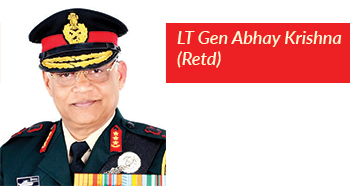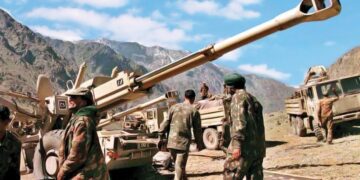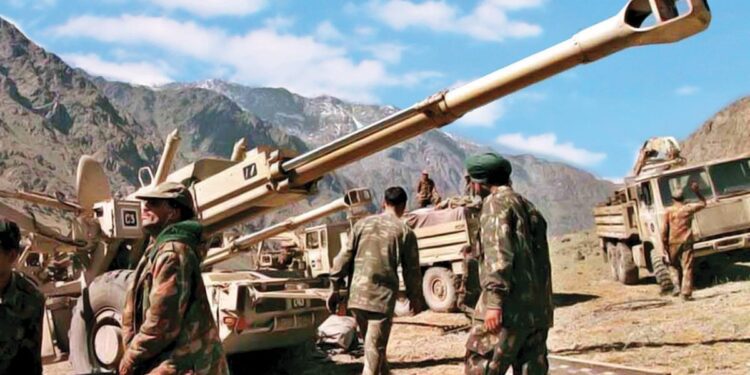 The use of expression ‘TwoFront War’ has gradually turned into a military terminology essentially to summarise the combined threat to the nation from both the Western and Northern fronts. Both Army and Air Force Chiefs, past and present, have been heard on a number of occasions reassuring the nation through various media interactions that India is always prepared to fight a Two-Front War. This repeated assurance definitely indicates availability of adequate resources and preparedness to take the battle into the adversary’s territory.
The use of expression ‘TwoFront War’ has gradually turned into a military terminology essentially to summarise the combined threat to the nation from both the Western and Northern fronts. Both Army and Air Force Chiefs, past and present, have been heard on a number of occasions reassuring the nation through various media interactions that India is always prepared to fight a Two-Front War. This repeated assurance definitely indicates availability of adequate resources and preparedness to take the battle into the adversary’s territory.
During the Indo-Pak war of 1971, India definitely fought on two fronts; but it was with a common adversary on both the fronts. Does the currently propagated concept of a Two-Front War mean fighting simultaneously on two specific fronts that is Western and Northern Fronts or fighting two different adversaries? The former involves two specific geographical segments while the latter may involve more than two directions or geographical regions.
Understanding terminology
Going back in time, one famous example of a Two-Front War in recent military history of the world is that of the aggressor Germany that chose to open two fronts simultaneously and later faced the consequences of spreading its forces to both East and West. For any aggressor, it is always wise to concentrate his forces on one front and take on his enemies one by one. In military terminology, therefore, a Two-Front War is one in which fighting takes place on two geographically separate fronts. It is usually executed by two or more separate forces simultaneously or nearly simultaneously, in the hope that their opponent will be forced to split his fighting force to deal with threats on both the fronts
However, talking about a TwoFront War scenario in India’s context, it seems a different ball game altogether, because India does not project herself as a potential aggressor. India always talks of defending her territorial integrity instead. A Two-Front War in respect of India will involve a combination of both China and Pakistan. But who out of the two will then start the war or will it be both and that too simultaneously? Let us examine and find the answer.
China failed in its objective
China had set out to teach India a lesson in 1962, but it is commonly believed that China could not achieve its objective. Rather, it landed up doing a favour to India by compelling the nation to shed the self-imposed restrictions and instead, embark on rebuilding its military power. Also, the 1962 conflict not only buried the charmed concept of ‘Hindi-Chini Bhai–Bhai’ for good; but also fuelled an enduring enmity and lack of trust between the two countries.
It will be interesting to note that though today, China’s military is being taken as a force to reckon with at the global level due to their reforms, modernisation and technological developments, the fact is that China has not fought any war post- 1979.
The People’s Republic of China and the Socialist Republic of Vietnam had fought a war in early 1979. China had launched an offensive in response to Vietnam’s actions against the Khmer Rouge in 1978. The war lasted for 27 days and finally, after suffering losses, China withdrew. Though China claimed victory in this war, but the fact was that Vietnamese occupation of Cambodia continued until 1989.
Interestingly, Chinese military had other failures too prior to 1979, where they suffered and withdrew without achieving any objective. Besides the war in Vietnam, China suffered defeat during the ChineseNorth Korean invasion of South Korea in 1950-53, Nathula clash of 1967 and Sino-Soviet border conflict of 1969 over the Zhenbao Island.
Instances of victory
However, China has a few instances of victory to boast about such as taking over of Tibet and successfully crushing the uprising in 1959, ChinaBurma border campaign where they succeeded in evicting Kuomintang in 1961 as also successfully established control over Paracel Islands of South Vietnam in 1974.
Post the 1962 war, as far as the Line of Actual Control (LAC) with India is concerned, differences in perception with regard to ownership over few geographical segments of the terrain along the LAC continue to linger which has often resulted into friction along the border. In the recent past, Doklam followed by Ladakh were the latest cases which turned into major standoff between the two Armies. Unlike the Line of Control (LOC) with Pakistan which perpetually burns, as far as the LAC with China is concerned, the last bullet was fired in 1973.
Conflict with Pakistan
India and Pakistan have fought several wars since August 1947. Soon after Independence, the Indian Army had to move into Kashmir on the request of its ruler Maharaja Hari Singh when Pakistan had managed to successfully push across the border close to Srinagar, a large number of armed tribesmen duly supported by the Pakistan Army.
Fierce encounters took place and the Indian Army managed to push the Pakistani forces back beyond a line when the ceasefire was signed in 1949 which later on was accepted as the LOC. As a result of the ceasefire, the remaining area of Kashmir known as Pakistan Occupied Kashmir (POK), could not be freed from Pakistani control.
The second war took place in 1965 when Pakistani soldiers once again attempted to cross over into Kashmir to ignite insurgency. It was a miscalculation on the part of Pakistan that India was militarily unprepared having suffered at the hands of Chinese in the 1962 war.
Provocative flashpoints
The third full scale war was fought in December 1971 when civil unrest had taken deep roots in East Pakistan seeking independence. India was badly affected as the entire region was thrown into turmoil with massive influx of refugees. India was left with no choice but to intervene militarily. Then came another intrusion attempt by Pakistan in Siachen, resulting in the Kargil conflict in 1999, which of course remained localised and did not escalate into a full-scale war for various reasons.
Apart from these military actions between the two countries since Independence, there have also been a number of provocative flashpoints which could have resulted into a major conflict. India has faced a number of major Pakistansponsored terrorist attacks on nonmilitary establishments such as the attack on the Indian Parliament in December 2001, blast in Samjhauta Express in February 2007, attack on Taj Hotel Mumbai in November 2008 and the suicide car bombing in Pulwama in February 2019 that killed 40 CRPF personnel. Apart from these flashpoints, terrorism in Kashmir Valley, terrorist attacks on military targets and frequent actions on the LOC continue as always.
(To be continued…) (The author is former Army Commander of South Western, Eastern and Central Army Commands, in the Indian Army














 G20 podium
G20 podium

